June 22nd, 1941. The day everything changed. Over 3 million German troops cautiously cross over into the Soviet Union. This was the beginning of the end.
Stalingrad was one of the Soviet Union’s key industrial cities. However, Adolf Hitler didn’t want it for its strategic advantages. No, he wanted it for its name.
Okay, Okay. I hear you saying, “What on earth is going on?”. Let’s rewind a bit, shall we?

Up till then, Germany had seen outstanding progress in Europe and the fall of France was no different. Hitler had hoped that the defeat in Western and Central Europe would knock out the British on the way. Annoyingly, it didn’t.
After the Battle of Britain, they had begun to grow into a notable threat. Not the type that was big enough to completely frighten the Third Reich, but one that they had to keep an eye on. Consequently, Hitler had to move on. Enough wasting time, Operation Barbarossa was on. Operation Barbarossa was the codename given to the plan to invade the Soviet Union. It began on June 22nd, 1941. Hitler believed that he could take down his ideological enemy in a matter of weeks. After all, he had stated in his book ‘Mein Kampf’ that the ‘Red Army’ (Army of the Soviet Union) would take 4 years to prepare.

- Hitler’s book, ‘Mein Kampf’, was published in 1925. It was written while he was waiting out his prison sentence, which he was spending in a comfortable hotel. The contents of the book cover how his beliefs were formed, and his future plans for Germany. However, something peculiar arose: he had quite shamelessly expressed his hatred of communism. Instances like this spanned over Hitler’s entire career. One crucial example is when he banned all political parties in 1933 that were against the Nazi Party, including the Communist party, which had 16.9% of the vote as of November of 1932.
Hitler didn’t just launch a brutal World War because he wanted power, or land, or influence. Yes, that was part of it, you simply can’t dismiss that. But his plan from the beginning was to demolish communism, as that is what was needed to take down the Soviet Union.
THE INVASION:
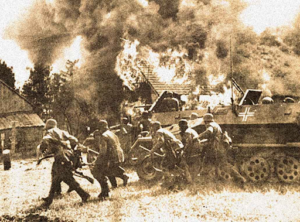
As mentioned earlier, the invasion unfolded on the 22nd of June. It did not take long for the German forces to push the Red Army all the way to Moscow. Infact, it only took them a month. The Soviet Union was in shambles. The Red Army was tough, but the Germans had complete air superiority, as they had destroyed most of the Soviet Air-Fields that were not considered up to date. How did they do that? You ask. There were two main tricks the Germans used that handed them staggering progress on a silver platter.
1 – Blitzkrieg: Blitzkrieg (meaning lighting war) is, according to www.history.com “a term used to describe a method of offensive warfare designed to strike a swift, focused blow at an enemy”.
This was achieved through identifying the enemies weaknesses, and then exploiting them. This disorganises your opponent, which certainly worked with the Soviets. Lastly, they would flank them – which brings me to my next point.
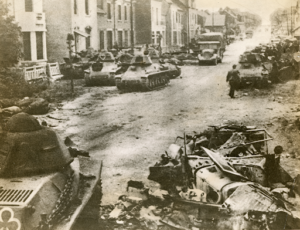
2 – Encirclement: Encirclement is, according to www.wikipedia.com “a military term for the situation when a force or target is isolated and surrounded by enemy forces.” Pretty Straight forward. To encircle an opponent, you needed to attack them from both sides – rather than the front – this is because forces on the sides tend to be weaker, less organised. Once you do break through the ranks and surround the opponent, you can then close in, and wipe them out with ease. Hitler used this excessively in the invasion of the Soviet Union, trapping troops in massive numbers and cutting down the enemy forces cleanly.
| City | No. of soldiers captured |
| Białystok-Mińsk | 341,000 |
| Smolensk | 310,000 |
| Kiev | 665,000 |
| Vyazma-Bryansk | 673,000 |
The Germans never made it past Moscow.
THE SIEGE:
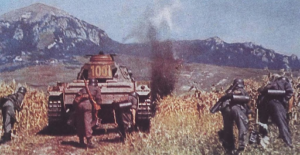
After a harsh winter, which not only gave the Soviets time to push them back, but also halted their movements, German progress was beginning to pick up.
The German War Machine was eating up massive amounts of fuel, so Hitler wanted to secure his supply of expensive oil. The Caucasus (An area consisting of modern day Armenia, Azerbaijan, Georgia and part of Southern Russia) is a region rich in oil. You can probably see where this is going…
Hitler took control of the Caucasus, giving him access to the oil there. The German 1st, 4th, and 17th Panzer Armies alongside the 3rd Romanian Army were sent to take the Caucasus, but the 4th Panzer Army (and a few Romanian and Italian allies) were ordered to continue eastward alone, while the other armies moved south. This was because Hitler wanted to humiliate Stalin by taking the city that bears his name.

Stalingrad was the city that Stalin had fought at in the Russian Civil War, and where he had won. It held personal value to him, and he was not about to let Hitler of all people take that from him. From July 28th, 1942, Stalin urged the Red Army and the citizens of Stalingrad to defend the city harshly, and throw everything they had at the invader. He preached that with a mix of encouraging patriotism, and love of the motherland, it might be enough to keep the Soviet people stand strong. They wanted revenge, for the killing of their sons, fathers, friends and family. “Not a step back!” was a slogan famously used to encourage the Soviet people to stay strong and keep the defence firm.
In the summer of 1942, The citizens of Stalingrad burned and destroyed everything that could be deemed useful to the German forces. They also dug ditches to slow down German tanks. The 23rd of August was a day of destruction – smoke was thick, as around 600 German bomber planes flew over the city, completely reducing it to rubble, with bombs weighing tons. Fires lasted for months. 40,000 Soviets died, but no one was allowed to leave. Food and supplies were scarce, as German bombers sunk the ships carrying essential food and drinking water.
Women in the Battle:
Women were part of the fight. And no, it wasn’t making weapons or sending messages like in Britain – It was Snipers, Fighter pilots, Soldiers, and Nurses who died on the battlefield. The number of women fighting were around the same number of men.
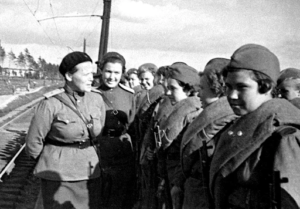
The River Volga was a river that Stalingrad was situated on. It was the last point that gave the Soviet Union a defence advantage. Slogans like “There is no land beyond the Volga” became popularised by Stalin and others to make sure that Stalingrad citizens knew that if the city fell, everything was over for the Soviet Union. The German advance was strong, and by mid-September there was growing confidence that the city would fall very soon.
A tough Soviet general named Vasily Chuikov was sent in by Stalin himself. Regarding his work in Stalingrad; he was deemed “Hero of the Soviet Union” twice, and even managed to get a Distinguished Service Cross from the United States. He was known to be close to his soldiers, and morale took a toll (for the better) once he was appointed to Stalingrad.
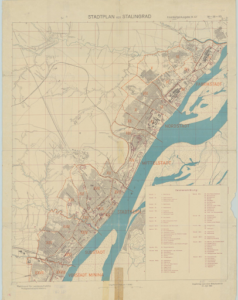
But that wasn’t the only thing that changed – in fact, without Chuikov, it’s highly likely that the Germans could’ve taken Stalingrad before Christmas. Chuikov wanted to get close. Closer to the Germans, hug the enemy and leave no space that the artillery and airforce of the German war machine needed. The land that the Soviets occupied was so small that precise and trained German pilots couldn’t drop their bombs on them. Fighting house-to-house was constant and there would sometimes only be a few feet between the opposing soldiers. Urban Warfare. It was brutal, dirty and risky. The average lifespan of a soldier fighting in Stalingrad was 24 hours. The rubble often caused large weapons to have trouble functioning. This also came with an advantage for snipers, who were used excessively by the Soviets – most of which were women! German soldiers thought the Soviets were some sort of beasts. The diary of a German soldier fighting in Stalingrad (William Hoffman) quotes “The Russians are not men, but cast iron creatures”.

This just displays the bravery of The Red Army, who threw away their lives to defend their country. Despite that, they still held out. The Soviet’s faithful ally – the harsh winter – kicked in by November. German supplies begin to run out – Many soldiers are affected by frostbite, and at this point, most look like corpses. Bodies pile up and rot away as there is nowhere to bury them. It’s a tough fight for both sides.
November 19th, 1942. A turning point at Stalingrad.
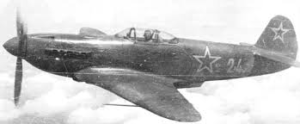
When the Germans first acted out Operation Barbarossa, Soviet factories were moved further east to keep them safe from Axis havoc. These factories were building new and sharp weapons, such as aircraft and tanks, in massive numbers. One notable aircraft was the Yak Fighter (commonly flown by women such as Lilia Litvyak). Some of the most modern planes of their time, they gave the SAF air superiority. The old tanks used by the Red Army that didn’t even include radio technology (they used signal flags) did not stand a chance against these new, modern, fast tanks that were built at an alarming rate.
Operation Uran (Uranus), executed by Konstantin Rokossovsky, was the operation planning to use these newly built weapons to their advantage. As they were better armed, 1 million Soviet soldiers broke through the Romanian flanks and trapped the German Soldiers concentrated in the front lines in the city. In 4 days, the soviet troops closed in and trapped 300,000 Axis soldiers. It was a replica of Hitler’s Blitzkrieg tactics, and when it was accomplished – everyone on the Soviet side was delighted.
Paulus, The commander of the 4th army trapped in Stalingrad, knew he had to break through the Soviet forces and link up with the rest of his troops outside. Pressure from Hitler to stay and fight in Stalingrad was intense, and Paulus couldn’t do anything but obey. The Führer refused to give up the city, and Paulus, who was extremely obedient, followed like a dog on a leash.
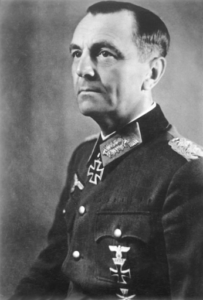
Commander-in-Chief of the Lufftwaffa Hermann Göring convinced Hitler that he was capable of organizing an Air-Lift that would supply Paulus’ army with food and other supplies like ammunition. This failed, of course, as Göring once again overestimated the ability of the Luftwaffe.
The Germans try to break in from the outside, but by Mid-December, it’s obvious that the Soviet Union has the upper hand. Later, The Red army squeezes in and separates the Germans into two small pockets close to the Volga. Paulus and his troops aren’t capable of fighting back, but Hitler refuses retreat. A fight to the death, that’s what he wants.
In an attempt to give him the strength and morale that he needed, Hitler promoted Paulus to Field Marshal, a rare title. Alas, on the 31st of January, 1943, Paulus surrendered.
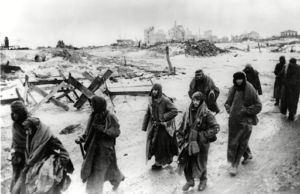
91,000 German soldiers were captured.
Only 5000 made it back to see the light of Germany ever again.
CONCLUSION:
Hitler thought that he could Blitzkrieg through the Soviet Union as he did through Europe. He convinced the German populus that the Slavic people were inferior to them, that they were unintelligent, incapable and weak. His mis-calculations would prove him wrong as his “invincible” army spent the next 3 years retreating, until hell was unleashed on Berlin.


